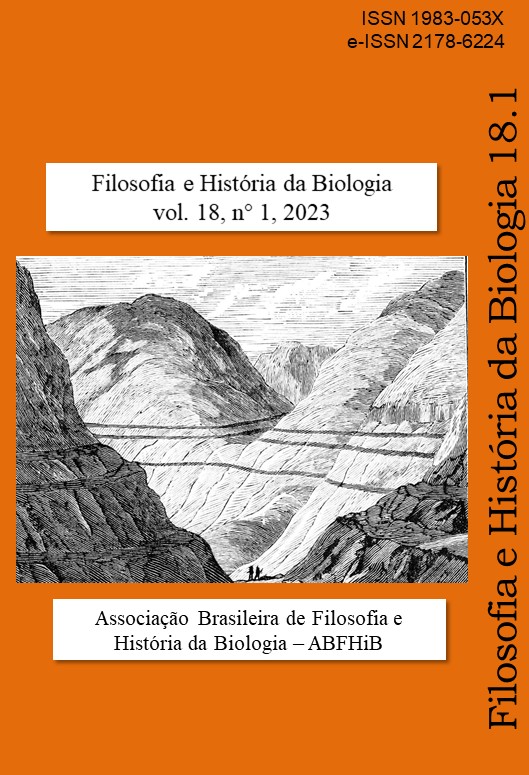An annotated translation of Thomas Browne’s Pseudodoxia Epidemica: Vulgar and common errors on animals in the 17th Century
DOI:
https://doi.org/10.11606/issn.2178-6224v18i1p17-35Keywords:
Thomas Browne, Pseudodoxia, Animals, ElephantAbstract
In 1646, the English physician Thomas Browne (1605-1682) published the Baconian-inspired encyclopedic work Pseudodoxia Epidemica, also known as Vulgar Errors. Browne discussed what would be pervasive errors on various topics, including animals. Besides explaining the origin of each conception, he discussed ideas and observations of other authors and, in many cases, presented his experiments and observations. He took eyewitness testimony as decisive. We offer a contextualized and commented translation of Chapter 1 of Book III of Pseudodoxia, in which Browne analyzed the view that the elephant has no joints.
References
ARISTOTLE. History of animals. [séc. IV a. C]. Trad. W. D. Ross. Chicago: Encyclopaedia Britannica, 1952. (Great Books of the Western World, 9).
ARIZA, Fabiana Vieira; MARTINS, Lilian Al-Chueyr Pereira. A scala naturae de Aristóteles na obra De generatione animalium. Filosofia e História da Biologia, 5 (1): 21-34, 2010.
BROWNE, Thomas, Sir. [1650]. Pseudodoxia epidemica: or enquiries into very many received tenents, and commnonly presumed truths. The second edi-tion corrected and much enlarged by the author. Together with some marginall observations and a table alphabeticall at the end. Pp. 95-240, in: ENDICOTT, Norman (ed.). The prose of Sir Thomas Browne. London: University of London Press, 1968.
BUTTERY, Amy Vargo. Revisions of the Book of Nature in 17th-century England. Atlanta, 1996. Thesis (PhD in English Literature) - Emory University.
CHALMERS, Gordon. Sir Thomas Browne, true scientist. Osiris, 2: 28-79, 1936.
FERRY, Georgina. Thomas Browne: a rarity among rarities. The Lancet, 389: 1687-1688, 2017.
HENTSCHEL, Ann; HENTSCHEL, Klaus. Translating in the history of science: A concerted effort. Isis, 109 (4): 760-766, 2018.
KEYNES, Geoffrey. Browne, Thomas. Vol. 2. Pp. 522-523, in: GILLISPIE, Charlton Coulston (ed). Dictionary of scientific biography. New York: Charles Scribners Sons, 1970.
LEIGHTON, Ann. Early American gardens: for meate and medicine. Massachusetts: University of Massachusetts Press, 1986.
MARTINS, Roberto de Andrade. Aristóteles e o estudo dos seres vivos. São Paulo: Livraria da Física, 2015.
MERTON, Stephen. Old and new physiology in Sir Thomas Browne: Digestion and some other functions. Isis, 57 (2): 249-259, 1966.
MERTON, Stephen. Sir Thomas Browne’s Theories of respiration and combustion. Osiris, 10: 206-223, 1952.
MERTON, Stephen. Sir Thomas Browne as zoologist. Osiris, 9: 413-434, 1950.
PLINY, the Elder. [77 d.C.-79 d.C.]. Natural History. Trad. H. Rackham. Cambridge, Mass.: Harvard University Press, 1938.
REEVES, Eileen; VAN HELDEN, Albert. Idiom and image: Translating the letters on sunspots. Isis, 109 (4): 767-773, 2018.
ROSIER, Lesli Carol. The knowing of Sir Thomas Browne (1605-1682). New York, 1999. Thesis (PhD in English Literature) - Fordham University.
STAAB, Nancy Ann. Renaissance collections and the culture of curiosity: a context for the curious writings of Sir Thomas Browne. Chapel Hill, 2000. Thesis (PhD in English Literature) - University of North Carolina.
STRABO. Geography. V. III. Book 17. Trad. Horace Jones. Cam-bridge, MA: Harvard University Press, 1932. (Loeb Classical Li-brary, 267).
TSU, Jing. Historians of science translating the History of science: Blur versus Grit. Isis, 109 (4): 789-795, 2018.
Downloads
Published
Issue
Section
License
Copyright (c) 2023 Filosofia e História da Biologia

This work is licensed under a Creative Commons Attribution-NonCommercial-ShareAlike 4.0 International License.
The published manuscripts become the property of the journal Philosophy and History of Biology, and the authors accept the terms of this license and agree to assign the copyright for publication, in addition to agreeing with the publication's commitment to offering open access to all of its content. The information and concepts issued in signed papers are the sole responsibility of their authors.


 cademia.edu
cademia.edu
